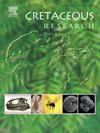标题一新齿状石,Piscidenticulus callapezi igen。isp。2011年11月,在葡萄牙中西部上白垩纪的鳄鱼形粪化石上
IF 1.7
3区 地球科学
Q1 GEOLOGY
引用次数: 0
摘要
描述了最近发现的保存在上白垩纪粪化石上的齿状石。粪化石很可能是由生活在西伊比利亚边缘浅水环境中的鳄形动物产生的。该标本采集于Tentúgal组(Tentúgal,葡萄牙中西部)底部的中Cenomanian碳酸盐-硅屑海相最上层。齿状体表现出独特的特征,包括一组直线、平行和等距的凹槽,间距比凹槽本身更宽。这些特征支持了新鱼属和鱼种Piscidenticulus callapezi的定义。这些齿状石被解释为粪化石表面反复的鱼咬行为的结果,可能是为了获取食物,这为白垩纪同形海鱼的古行为学提供了鲜为人知的重要数据。本文章由计算机程序翻译,如有差异,请以英文原文为准。
A new dentalite, Piscidenticulus callapezi igen. et isp. nov., on a crocodylomorph coprolite from the Upper Cretaceous of west-central Portugal
Recently discovered dentalites preserved on an Upper Cretaceous coprolite are described. The coprolite was likely produced by a crocodylomorph that lived in a shallow water, marginal environment along the West Iberian Margin. The specimen was collected from an uppermost middle Cenomanian carbonate-siliciclastic marine bed, at the base of the Tentúgal Formation (Tentúgal, west-central Portugal). The dentalites exhibit unique characteristics, including sets of straight, parallel, and equidistant grooves, with separations wider than the grooves, themselves. These features support the definition of the new ichnogenus and ichnospecies Piscidenticulus callapezi. The dentalites are interpreted as the result of repeated fish-biting behaviour on the surface of the coprolite, likely in an attempt to obtain food, providing significant data on the scarcely known palaeoethology of Cretaceous homodont marine fishes.
求助全文
通过发布文献求助,成功后即可免费获取论文全文。
去求助
来源期刊

Cretaceous Research
地学-地质学
CiteScore
4.10
自引率
19.00%
发文量
235
审稿时长
12 weeks
期刊介绍:
Cretaceous Research provides a forum for the rapid publication of research on all aspects of the Cretaceous Period, including its boundaries with the Jurassic and Palaeogene. Authoritative papers reporting detailed investigations of Cretaceous stratigraphy and palaeontology, studies of regional geology, and reviews of recently published books are complemented by short communications of significant new findings.
Papers submitted to Cretaceous Research should place the research in a broad context, with emphasis placed towards our better understanding of the Cretaceous, that are therefore of interest to the diverse, international readership of the journal. Full length papers that focus solely on a local theme or area will not be accepted for publication; authors of short communications are encouraged to discuss how their findings are of relevance to the Cretaceous on a broad scale.
Research Areas include:
• Regional geology
• Stratigraphy and palaeontology
• Palaeobiology
• Palaeobiogeography
• Palaeoceanography
• Palaeoclimatology
• Evolutionary Palaeoecology
• Geochronology
• Global events.
 求助内容:
求助内容: 应助结果提醒方式:
应助结果提醒方式:


